Silk

Silk is a natural protein fiber, some forms of which can be woven into textiles. The protein fiber of silk is composed mainly of fibroin and produced by certain insect larvae to form cocoons. The best-known type of silk is obtained from the cocoons of the larvae of the mulberry silkworm Bombyx mori reared in captivity (sericulture). The shimmering appearance of silk is due to the triangular prism-like structure of the silk fibre, which allows silk cloth to refract incoming light at different angles, thus producing different colors. Use of Spider silks to produce novel, protein-based, eco-friendly materials for use in medical, cosmetic, electronic, textile, industrial, and other applications is also under research. ''Believe it or not, Silk is one of the most recommended fabrics for people who have skin conditions like psoriasis and eczema as it helps regulate temperature and breathable material.
Quotes
[edit]- Quotes are arranged alphabetically by author
A - F
[edit]
Stronger than an evening fire
My heart yearns with desire
To build with you a burning pyre
That rivals the beauty of angelic choir
In you I see both beauty and grace
Each time I gaze upon your brilliant face
For you are Beauty draped in silk and lace... - John Allen
- Silk and Lace
Stronger than an evening fire
My heart yearns with desire
To build with you a burning pyre
That rivals the beauty of angelic choir
In you I see both beauty and grace
Each time I gaze upon your brilliant face
For you are Beauty draped in silk and lace
And in your eyes my heart has found its place
To speak with you is like Autumn wind
The world is kind when you and I see the day begin
Together embraced in silk and lace a passion that knows no end
Though we are not lovers loving under covers I am glad to know you as a friend.- John Allen in: Silk and Lace, poetrysoup.com

- She maketh herself coverings of tapestry; her clothing is silk and purple. It looks as if she did not neglect herself. The coverings mentioned are for her bed. She took time to decorate and adorn her bedroom with beautiful bedspread, pillows etc. her clothing is attractive and made of silk. Silk was one of the finest linens from Egypt.
- Bible in: Anna Scott Bradley All I's for You , AuthorHouse, 29 February 2012, p. 92

- HANDKERCHIEF, n. A small square of silk or linen, used in various ignoble offices about the face and especially serviceable at funerals to conceal the lack of tears. The handkerchief is of recent invention; our ancestors knew nothing of it and entrusted its duties to the sleeve. Shakespeare's introducing it into the play of "Othello" is an anachronism: Desdemona dried her nose with her skirt, as Dr. Mary Walker and other reformers have done with their coattails in our own day --an evidence that revolutions sometimes go backward.
- Ambrose Bierce in: The Devil's Dictionary, Digireads.com Publishing, 1 January 2004, p. 60
- It's funny how worms can turn leaves into silk.
But funnier far is the cow:
She changes a field of green grass into milk
And not a professor knows how.- Dorothy Caruso in: Enrico Caruso his life and death, 1945, p.42

It is not the weight of jewel or plate,
Or the fondle of silk or fur;
'Tis the spirit in which the gift is rich,... - Edmund Vance Cooke
- The Spirit of the Gift
It is not the weight of jewel or plate,
Or the fondle of silk or fur;
'Tis the spirit in which the gift is rich,
As the gifts of the Wise Ones were,
And we are not told whose gift was gold,
Or whose was the gift of myrrh.- Edmund Vance Cooke in:The Kindergarten for Teachers and Parents, Volumes 17-18, Alice B. Stockham & Company, 1904, p. 211
- BLACK SILK DRESS
Her black silk dress
Fitted her like a sheath
The taut lines showed
Her nakedness beneath
Save for black-stockings
Gartered at the thigh
Stimulating to the loins
And pleasing to the eye
She turned every head
With her glamorous allure
Filled each one with thoughts
None of which were pure- Paul Curtis in: Black Silk Dress, poetrysoup

- According to an ancient Chinese legend, one day in the year 240 BC, Princess Si Ling-chi was sitting under a mulberry tree when a silkworm cocoon fell into her teacup. When she tried to remove it, she noticed that the cocoon had begun to unravel in the hot liquid. She handed the loose end to her maidservant and told her to walk. The servant went out of the princess's chamber, and into the palace courtyard, and through the palace gates, and out of the Forbidden City, and into the countryside a half mile away before the cocoon ran out. (In the West, this legend would slowly [[w:Mutate|mutate over three millennia, until it became the story of a physicist and an apple. Either way, the meanings are the same: great discoveries, whether of silk or of gravity, are always windfalls. They happen to people loafing under trees.
- Jeffrey Eugenides in:Middlesex: Reissued, Bloomsbury Publishing,3 October 2011, p. 63
- They don't farm silk in America. They wear clothes, don't they? Or do they go around naked? If they wear clothes, they need silk. And they can buy it from me. “Okay, whatever you want. Just hurry.”
- Jeffrey Eugenides in: "Middlesex: Reissued", p. 43
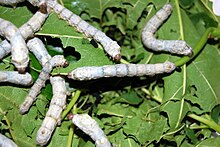
- My family might never have become silk farmers if it hadn't been for the Emperor Justinian, who, according to Procopius, persuaded two missionaries to risk it. In 550 AD, the missionaries snuck silkworm eggs out of China in the swallowed condom of the time: a hollow staff. They also brought the seeds of the mulberry tree. As a result, Byzantium became a center of sericulture. Mulberry trees flourished on Turkish hill sides. Silkworms are the leaves, Fourteen hundred years later, the descendants of those stolen eggs filled my grandmother’s silkworm box in Guilin.
- Jeffrey Eugenides in: "Middlesex: Reissued", p. 71
- Orthodox monks smuggled silk out of China in the sixth century. They brought it to Asia Minor. From there it spread to Europe, and finally traveled across the sea to North America. Benjamin Franklin fostered the silk industry in Pennsylvania before the American Revolution. Mulberry trees were planted all over the United States.
- Jeffrey Eugenides in: "Middlesex: Reissued", p. 396
- The most widely raised type of silkworm, the larva of Bombyx mori, no longer exists anywhere in a natural state. The legs of the larve have degenerated, and the adults do not fly.
- Jeffrey Eugenides in: "Middlesex: Reissued", p. 397
- A Silk Rose
I run my hands down your silk shoulders
till our hands are in each others.
As our bodies lightly touch,
these lips can only kiss.
I whisper softly
my only words,
I love you
always- Michael J. Falotico in: A Silk Rose, poetrysoup.com
G - L
[edit]- Your thought advocates fame and show. Mine counsels me and implores me to cast aside notoriety and treat it like a grain of sand cast upon the shore of eternity. Your thought instills in your heart arrogance and superiority. Mine plants within me love for peace and the desire for independence. Your thought begets dreams of palaces with furniture of sandalwood studded with jewels, and beds made of twisted silk threads. My thought speaks softly in my ears, "Be clean in body and spirit even if you have nowhere to lay your head." Your thought makes you aspire to titles and offices. Mine exhorts me to humble service.
- Khalil Gibran in: The Khalil Gibran Megapack: 43 Classic Works, Wildside Press LLC, 10 November 2013, p.468
- Narrated Hudhaifa: The Prophet said, "Do not drink in gold or silver utensils, and do not wear clothes of silk or Dibaj, for these things are for them (unbelievers) in this world and for you in the Hereafter."
- HADITH Sahih Bukhari 7:69:537
- Narrated 'Abdullah bin Umar: Umar bought a silk cloak from the market, took it to Allah's Apostle and said, "O Allah's Apostle! Take it and adorn yourself with it during the 'Id and when the delegations visit you." Allah's Apostle (p.b.u.h) replied, "This dress is for those who have no share (in the Hereafter)." After a long period Allah's Apostle (p.b.u.h) sent to Umar a cloak of silk brocade. Umar came to Allah's Apostle (p.b.u.h) with the cloak and said, "O Allah's Apostle! You said that this dress was for those who had no share (in the Hereafter); yet you have sent me this cloak." Allah's Apostle said to him, "Sell it and fulfill your needs by it."
- Sahih Bukhari 2:15:69, See also: Sahih Bukhari 3:47:782, and Sahih Bukhari 8:73:104
- Narrated 'Ali: The Prophet gave me a silken dress as a gift and I wore it. When I saw the signs of anger on his face, I cut it into pieces and distributed it among my wives."
- Sahih Bukhari 3:47:784, See also: Sahih Bukhari 7:64:279
- Narrated Anas: A Jubba (i.e. cloak) made of thick silken cloth was presented to the Prophet. The Prophet used to forbid people to wear silk. So, the people were pleased to see it. The Prophet said, "By Him in Whose Hands Muhammad's soul is, the handkerchiefs of Sad bin Mu'adh in Paradise are better than this." Anas added, "The present was sent to the Prophet by Ukaidir (a Christian) from Dauma."
- Sahih Bukhari 3:47:785, see also: Sahih Bukhari 4:54:471
- Narrated Abu 'Amir or Abu Malik Al-Ash'ari: that he heard the Prophet saying, "From among my followers there will be some people who will consider illegal sexual intercourse, the wearing of silk, the drinking of alcoholic drinks and the use of musical instruments, as lawful. And there will be some people who will stay near the side of a mountain and in the evening their shepherd will come to them with their sheep and ask them for something, but they will say to him, 'Return to us tomorrow.' Allah will destroy them during the night and will let the mountain fall on them, and He will transform the rest of them into monkeys and pigs and they will remain so till the Day of Resurrection."
- Sahih Bukhari 7:69:494
Spider silk
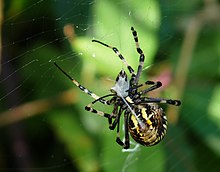
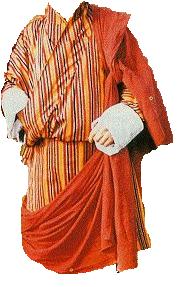
- For me, each day begins and ends with wanting to learn a little more about the secrets of spider silk. Spiders have been around for over 300 million years and are found in nearly every terrestrial environment. There are more than 40,000 species living today and each spins at least one type of silk. However, most spiders spin more than one type of silk. For example, the orb-web weaving spiders that are commonly seen in gardens during the day or near porch lights at night, typically make seven kinds of silk. Each silk is chemically and functionally distinctive.
- Cheryl Hayashi in: The secrets of spider silk, CNN.com
- An individual spider can produce multiple varieties of silk because it has numerous silk glands inside its body. Some silk glands make one type of silk, another set of silk glands makes a second type of silk, and so forth. One of the unforgettable moments in my life was the first time I dissected a spider and saw its stunningly beautiful, translucent silk glands.
- Cheryl Hayashi in: "The secrets of spider silk"
- What's the difference between spider silk and silkworm silk, the kind of silk in a typical silk scarf or blouse. Silk used in textiles is spun from the mouths of caterpillars to form cocoons that protect them while they transform into moths. A silkworm has only one pair of silk glands and can make one type of [[w:Fiber}fiber]].
- Cheryl Hayashi in: "The secrets of spider silk"
- Spiders, in contrast, have many silk glands, and the silk emerges from spinnerets located towards the rear of their bodies. Spiders are also able to spin silk from when they are very young and continue to do so throughout their lives.
- Cheryl Hayashi in: "The secrets of spider silk"
- Researchers are drawing inspiration from spider silks to produce novel, protein-based, eco-friendly materials for use in medical, cosmetic, electronic, textile, industrial, and other applications. The potential is enormous, especially considering the mind-boggling diversity of spiders and their silks.
- Cheryl Hayashi in: "The secrets of spider silk"
- Golden silk with deep red tie
Folded in golden silk
with deep red tie of the same
tucked inside a bedside drawer
this is for what she came...
holding to her heart these now opened letters
with tear stains she has no shame
the i love yous wrapped in golden silk
with deep red tie of the same.- Melisa Karpinske in angel4eva1976]] in:Poetry, gotpoetry.com
- So now our dear old Santa, he's a picture of health.
Now that he's so much thinner, he moves with greater stealth.
Please don't leave him cookies, forget about the milk.
Perhaps some sexy boxers, Mrs. Claus prefers them silk.- Richard Lamoureux in: Silk For Santa Claus, poetrysoup.com
- The eighteenth century was "The Age of Silk”. It was the fabric of power and class command. Gainsborough painted not people so much as displays of silken extravagance.
- Peter Linebaugh in: "The London Hanged: Crime and Civil Society in the Eighteenth Century", p. 256
- The lace man might then sell or put out the purl to the silver-thread-spinner, who, by intertwining purl and silk, made an embroiderer's thread called 'sleysy'. The lace man's shop had equipment consisting of wheels and spindles much like those at a rope-walk.
- Peter Linebaugh in: "The London Hanged: Crime and Civil Society in the Eighteenth Century", P. 229
M - R
[edit]- I have been much amused at ye singular φενόμενα [phenomena] resulting from bringing of a needle into contact with a piece of amber or resin fricated on silke clothe. Ye flame putteth me in mind of sheet lightning on a small—how very small—scale.
- Sir Isaac Newton in: The Electrician, Volume 6 , James Gray, 1881, p.279


- I looked at the inchworm dangling from the silk in my hand and said: "Think how nature makes things compared to how we humans make things." We talked about how animals don't just preserve the next generation; they typically preserve the environment for the ten-thousandth generation. While human industrial processes can produce Kevlar, it takes a temperature of thousands of degrees to do it, and the fiber is pulled through sulfuric acid. In contrast, a spider makes its silk - which per gram is several times stronger than steel - at room temperature in water.
- Bill Powers in: Twelve by Twelve: A One-Room Cabin off the Grid & Beyond The American Dream, New World Library, 6 October 2010, P.73
- ...touched the silk thread which the caterpillar makes benignly from the protein fibroin...think of its metamorphosis in its cocoon, a churning of natural juices, enzymes – and out comes a butterfly. Where are the toxics in that?
- Bill Powers in: "Twelve by Twelve: A One-Room Cabin off the Grid & Beyond The American Dream", p. 74
- We are all Adam's children, but silk makes the difference.
- Proverb in: Peter Linebaugh The London Hanged: Crime and Civil Society in the Eighteenth Century, Verso, 2003, p.257
S - Z
[edit]- “Do not wear silk, for one who wears it in the world will not wear it in the Hereafter” (5150).
- Sahih Muslim. Quoted from Ram Swarup, Understanding Islam through Hadis, 1983. [1]
- Queen Elizabeth [the First] owned silk stockings. The capitalist achievement does not typically consist in providing more silk stockings for queens but in bringing them within the reach of factory girls in return for steadily decreasing amount of efforts.
- Yuichi Shionoya in: Schumpeter and the Idea of Social Science: A Metatheoretical Study, Cambridge University Press, 19 July 2007

- Well, we realised that we have to move with the times, adapt to change. Also, this is a way of capturing a larger segment of the market. The new designs will mean more takers among the younger age groups, who look for trendy designs, and new looks. The older age group will now have something different-looking to add to their existing classic-design collection. …All these innovations are being done without in any way tampering with the purity and uncompromising quality that has characterised Mysore silk fabrics - including saris — for decades.... Although we are giving the body of the sari an element of interest with these innovations, we are seeing to it that it doesn't kill the inherent beauty of the fabric.
- P. Vijayan, in Modern MYSURU, about getting a Geographical Indication (GI) patent for Mysore Silk], The Hindu, 5 March 2005
- This is one element [kasuti-embroidery fusion] I always missed in a Mysore silk saree. So, I had to go for Kancheepuram, Peddapuram [saris] or Banaras when I needed to wear a very heavy-looking sari. Now, I have bought one and even gifted another to my sister-in-law as part of her wedding trousseau.
- Nandana Roy, on Kasuti-embroidery fusion of silk, quoted in: "Modern MYSURU".
Chinese Art & Culture
[edit]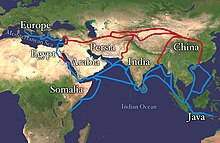

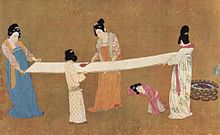
Clare Hibbert in: Chinese Art & Culture, Heinemann-Raintree Library, 2005
- China has been famous for its silk for thousands of years. The main trade route linking China to the West was even known as the Silk Road. The ancient Romans prized Chinese silk and imported both thread and cloth. The Chinese kept their methods of silk production a closely held secret, and so Westerners were unable to make their own. Knowledge of silk making gradually spread west after two Persian monks smuggled some silk worm eggs out of China in the 6th century C.E. However, China remained the world’s key producer.
- In: p. 30
- Silk. production. The ancient Chinese method of silk making, or sericulture, involved hatching many silk moth eggs at the same time. The caterpillars were then kept on bamboo trays and fed hand-picked mulberry leaves. Some cocoons were allowed to develop into adult moths so that they could produce more eggs. The rest were dropped into boiling water, which made each cocoon unwind to produce a single fiber that could be over half mile (nearly a kilometer long).
- In: p. 31
- Silk tapestry, or kesi appeared in China during the Tang dynasty around the 7th century C.E. In silk tapestry, both the background [[w:Fabric|fabric and the foreground threads are made of silk. Tapestry artists favored big, bold designs without repeats.
- In: p.32
- Plain silk fabric can be tie-dyed or printed. Artisans use simple printing blocks to create colourful, repeated designs. For more luxurious reults, silks can be hand-painted or embroidered.
- In: p .32
- Summer robes were made from light, cool silk. Those for winter wear were [[w:Quilt|quilted — two layers of silk were stitched together, with a thick layer of warm padding in between. Quilting is still a popular technique in modern China for creating cozy dresses and jackets.
- In: p. 33
- The tradition of painting on silk emerged in the 3rd century BC., with painters producing banners and scrolls....Between the 4th and the 10th centuries silk painted concentrated on human figures. They depicted their clothes and movements with graceful brush strokes.
- In: P. 34
- It [qin] has seven silk or metal strings and a long soundbox, with marks showing the positions of thirteen particular pitches. The qin was a favorite instrument of scholar-poets because its plucked strings create delicate, magical notes.
- In: P. 43
- China's earliest contact with the rest of the world was via the Silk Road, along which Chinese silks were transported through the Middle East and into Europe. In return, traders brought foreign goods, such as wool, glass beads, silver, and gold into China.
- In: p.48
Global Silk Industry: A Complete Source Book
[edit]



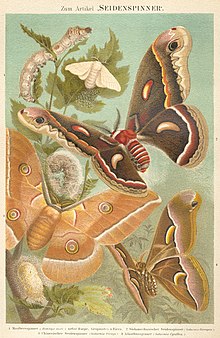




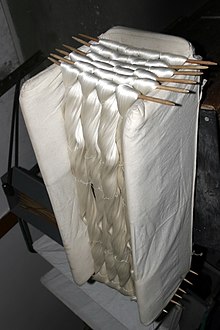

R.K.Datta in: Global Silk Industry: A Complete Source Book, APH Publishing, 1 January 2007
- The history of silk development spans through centuries and can be traced around the world's very ancient trade route called 'Silk Road'. A UNESCO inspired team trekked this obscure yet historical caravan tract called ‘Silk Road’, which began in China, passed through Tashkent, Baghdad, Damascus, Istanbul and reached European shores. Since the beginning of the Christian era (by 126 BC) silk has been the most coolourful of world caravans. Fabulous silks from China and India were carried to Europe through this 6400 km long road.
- In: p. 13
- It seems sericulture entered Europe during 140-86 BC. India also has long 3000-year history of silk development and at present ranks second to China in multi-varieties of silk production.
- In: p. 13
- China zealously guarded the secret of silk for about 3,000 years and plied a prosperous silk trade with the rest of the world. The merchant navies and the Chaldees carried fabulous silks from China to the courts of Babylon and Nineveh.
- In: p. 15
- In India the silk culture dates to antiquity. According to historians, mulberry culture spread to India by about 140 BC from China through Khotan.
- In: p. 15
- Even though mulberry culture may have come to India overland from China, the references in old scriptures definitely point out that India cultivated some kind of wild silks independently of China from the time immemorial. The ancient religious scripture, Rigveda, mentioned ‘urna’, generally translated as some sort of silk.
- In: p. 16
- Francis I did all he could to encourage and support sericulture and is the first French King to wear pure silk stockings. After Francis l, Both Henry II and Henry III patronized the silk weaving industry but it was Henry IV who introduced silkworm rearing into France.
- The saga of silk success and shortcomings during the twentieth century is just astonishing. For the first 40 years until the nylon hit the market silk trade reached an all-time high demand mainly for the women's stockings.
- In: p. 23
- ... the important factor affecting the growth of global silk trade during 1990s was the imposition of quotas by European Union and the United States on imports of
100 percent silk products. This was done to contain the explosive rise in imports silk garments, mostly sand-washed from China and Hongkong which raised eyebrows of the manufacturers in Europe and USA.
- In: p. 26
- Though silk production is less than 0.2 per cent of the world textile output, its production base is spread over 60 countries in the world with Asian nations bagging lion's share of over 90 per cent of mulberry production and almost 100-percent of non-mulberry silk....India is the world’s second largest producer with unique output of four varieties of silk – mulberry, tasar, eri, and moga.
- In: p. 31
- Sericulture, silk reeling and weaving have been practiced in the ancient trading capital of Shanghai. Shanghai has several modern silk processing plants and is also serving as captive units of American large buying houses.
- In: p. 35
- Karnataka, earlier known as Mysore, abound with silk, sandal wood and gold, the three most sought-after natural commodities . Karnataka is now the main mulberry silk producing state in India, contributing about two thirds of the output. Over 1 million families earn their living by cultivating bush mulberry, rearing silkworms and harvesting cocoons five to six times a year. Bangalore is the silk capital of India with the headquarters of CSB and its affiliated research located there.
- In: p. 41
- Silk processing in EU is concentrated in Milan and Como in Italy, Lyon in France and Zurich in Switzerland; same high quality silk weaving, jacquard, and printing are undertaken in the United Kingdom. Italy and France specialize in designer fabrics and scarves from famous fashion houses.
- In: p. 63
- Silkworm Rearing, Cocoon Harvesting The silk caterpillar, belong to the Order of Lepidoptera winged insects, genus Bombyx. The species Bombyx mori, which can be cultivated indoors, produces over 90 per cent of the world output of raw silk used commercially. There are other types of wild silkworms under the genus Saturnidae.
- In: p. 73
- Silk is crystalline, homogeneous in structure, [[w:Hygroscopic|hygroscopic in nature, light in weight, and is the longest and the strongest of all natural fibers. Soft, lustrous, and hygienic and also has an excellent affinity to dyes. Silk does not catch fire as easily as nylon and wool.
- In: p. 103
- Success of silk processing depends on quality of silkcocoons, which form integral part of raw silk production and sericulture...Silk is produced and secreted from the external secreting gland (exocrine gland). It is derived from the ecoderm and appears at about 36 hours prior to the rotation (blaktokinesis)...Silk gland can be distinctly divided into three divisions, anterior, middle and posterior....its composition includes spinneret, anteriror division, middle division, and posterior division.
- In: p. 103
- spinneret: It is a delicate tube inside the posterior part of the primary stage of silk gland. It comprises three parts, viz. spinning area, thread press and common tube. On the dorsal, lateral and ventral sides of thread press, six sets of musculus fibers develops which makes use of their expansion, contraction, flexibility for regulating the flow of silk substance, coarseness of silk as well as pressure in silk formation.
- In: p. 104
- The weight of the silk filament is decided by the weight of the cocoon shell and silk percentage of cocoon shell. In the reeling factory, raw silk percentage of cocoons and reeling discount of dried cocoons are used. The weight of the cocoon shell and the uniformity of cocoon are considered important commercial factors in raw silk reeling that are closely related to the raw silk yield to be obtained.
- In: p. 121
- The neatness and some cleanness of raw silk are directly influenced whereas size deviation, tenacity and cohesion of raw silk are indirectly influenced by the breed characteristics of the cocoons. The degree of neatness of raw silk is determined on the basis of incidence of the occurrence of defects which are smaller than those classified as “minor cleanliness defects”.
- In: p. 123
- The silk reeled on small reels is soaked in permeation chamber kept at low pressure [vacuum up to 400mm of (Hg) mercury/torr before re-reeling. The emulsion medium is water with non-ionic wetting agent and lubricating oil. The permeation of liquor is effected three times to facilitate easy unwinding of silk from the small reels.
- In: p. 137
- Before spinning a cocoon, the silk builds a hammock, an anchorage to hold its cocoon. This material is known as floss or blaze (Italian:Shelia, Japanese: Kebab). The quantity is small and the quality is poor, but it can be used for noil spinning.
- In: p. 142
- From Filament to Fabric Silk seems to have played an important role in the development of loom and weaving technology. Traces of primitive looms and woven fabrics are found in excavations in Egypt, China, India and Peru (2500 to 400 BC)...The silk weavers of China innovated the use of heddle and draw loom, a revolutionary development over the primitive tribal loom. India invented a foot tradle for silk weaving, a technical innovation over the ancient loom.
- Raw silk: The silk thread produced by the reeling together of the baves of several cocoons. Raw silk has no twist.
Poil: A silk yarn formed by twisting raw silk. The twist may be very slight or exceed 3,000 per meter.
Tram: A silk yarn formed by doubling two or more raw silk threads and then twisting them slightly, generally 80 to 150 TPM.
Crepe: Silk yarn made by several raw silk threads and twisting them to very high levels in the range of 2000 to 4000 TPM.- In: p. 149
- Silk can be woven into all the three basic weaves: plain or tabby twills and [[w:Satin|satin]s. Tabby silk weave produces, among others, taffeta and poplin. Tapestry weaves in silk have been used to weave ceremonial and decorative dresses and tapestries.
- In: p. 154
- Fabrics are degummed and bleached, if they are woven with yellow raw silk. Silk fabrics like other fabrics (cotton, manmade, wool and others) can broadly divided into mechanical and chemical finishing. The objective of mechanical finishing is to impart or improve certain desirable qualities like drape, fall or handle, feel stiffness, weight etc; but most of the mechanical finishes are only temporary.
- In: p. 159
- Silk sateen: The sateen is usually woven with degummed silk yarn but sometimes there are also fabrics woven with raw silk, which are degummed after weaving. The former is called glossed silk sateen and the latter is silk sateen.
- In: p. 176
- Although the bulk of world raw silk supply is spun by the domesticated silk moth, Bombyx mori, there are other sericigenous insects which spin cocoons and their yarn is equally pure silk. There silks are known as wild silk as differentiated from cultivated ‘mulberry silk’. The wild silk moths are abundantly found in remote regions, hilltops and forest interiors in [Burma, China, India, Korea, equatorial Africa and Southeast Asia. In fact, according to one authority, there are between four to five hundred different types of wild moths spinning silk cocoons; but only a few of these moths have commercial values.
- In: p. 179
- World Raw silk Trading: Raw silk is an important international trade commodity traded at the main commodity markets of New York, Lyon and London. Japan used to dominate the world silk market with her leading position as the top exporter, followed by China and Korea. Since 1869s China has taken over the market and Japan has reversed her role, emerging as a leading importer of raw silk
- In: p. 243
- The USA, which used to be the biggest single importer of raw silk until the 1960s has now grown into a leading importer of finished silk cloth by reducing the import of raw silk and waste silk. With the rising weaving costs, the USA prefers to import finished fabric to raw silk.
- In: p. 246

